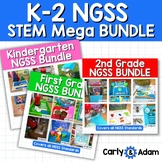Ricky the Rock Kindergarten Science Force and Motion Kindergarten STEM Activity
- PDF
What educators are saying
Also included in
- This bundle has it all! STEM challenges and science activities for every Kindergarten, 1st grade, 2nd grade, 3rd Grade, 4th Grade, and 5th Grade Next Generation Science Standard! This mega bundle includes 97 Science investigations and STEM Challenges covering every K-5 NGSS Topic. Each isdesigned wiPrice $147.00Original Price $338.50Save $191.50
- The first 4 STEM lessons for you to teach Kindergarten Physical Science!In this Kindergarten STEM Activities BUNDLE, students learn about the sun and how it effects us, pushes and pulls, force and motion, and more! Students build shade structures, force and motion designs, complete sun investigationPrice $10.00Original Price $14.00Save $4.00
- Activities for every single Kindergarten NGSS Standard!This bundle has it all! Students learn about Force and Motion, Weather, the Environment, Life Science, Earth Science, Engineering, Animal Habitats, The Sun, Solar Heat, and more!Students conduct investigations, use engineering, and science to doPrice $30.00Original Price $49.00Save $19.00
- This bundle has it all! STEM challenges and science activities for every Kindergarten, 1st grade, and 2nd grade Next Generation Science Standard! This mega bundle includes 42 Science investigations and STEM Challenges covering every K-2 NGSS Topic. Each isdesigned with their specific grade in mind.KPrice $75.00Original Price $147.50Save $72.50
Description
Teach about Force and Motion with Kindergarten STEM!
Amazing resource for STEM club, STEM teachers, elementary librarians, parents who love hands-on learning, and elementary teachers who want to create a hands-on educational environment in their classroom!
In the story, Ricky could’t roll like all of the other rocks because of his shape. Ricky’s friends added different materials to Ricky to change his shape.
In this STEM Challenge, students add materials to help their rock roll better. Then, they examine how to push and pull their rock.
This STEM Challenge aligns to NGSS Engineering Standards for Kindergarten, but can be used in 1st grade.
Material List:
- Ricky, the Rock That Couldn't Roll by Jay Miletsky
- Teacher Demonstration Materials: toy items that can roll or move (cars, balls, etc.)
- Flat Rocks
- Paper
- Tin Foil
- Tape
- Rubber Bands
Includes:
- Teacher Instructions
- Student STEM Journal
- Student Instructions
- STEM Activity
- Vocabulary Words (Push, Pull, Force)
- Student Reflection Sheet
- Rubric
- TpT Easel Version
Aligns to NGSS K-PS2-1
Plan and conduct an investigation to compare the effects of different strengths or different directions of pushes and pulls on the motion of an object.
Learning Objective
I can make objects move in different ways.









